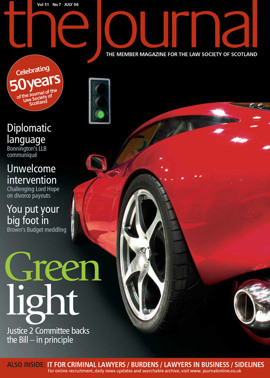Case for the defence

Sometimes it’s hard being a criminal lawyer. Aside from the obvious problems with dinner parties and taxi drivers (“how can you defend someone you know is guilty”, etc), the job itself can be very demanding. The law changes almost by the week, while legal aid rates change, at best, by the decade. Criminal practices are usually fairly small scale; the managers tend to be the principal fee earners, who are rarely able to devote time or energy to practice development.
As a result, many criminal firms have been slow to invest in IT (information technology, or computer) systems. Some practitioners are reluctant to spend large sums on their business when the legal aid system is in a state of flux, and margins are tight. Some feel there is no real need to do so. Others recognise they are not qualified to identify the potential uses of IT, and do not know where such knowledge might be accessed.
It might then come as a surprise to discover that criminal work is one of the practice areas which has most to gain from the sensible application of IT. Computer systems can’t do a summary trial (although they could probably stretch to a two-cop breach), but they are very useful in cutting down on the administration required to run a practice. Criminal firms usually operate on a high-volume, low-margin model. Given that they are largely funded by legal aid, and run by partners who spend most of their time in court, practices tend to be very admin-heavy. A decent case management system (a piece of software that organises files and diaries) can make a major difference, especially if it also deals with preparing and lodging accounts.
Until now, the use of IT has been largely optional. While some firms have invested in good IT systems, making them more efficient and profitable, others (perhaps the majority) have not. However, the time is fast approaching when, just as with phones and fax machines, computer systems will be a non-negotiable part of any criminal practice. What makes this inevitable is that other parts of the justice system (including the courts, Crown and SLAB) are beginning to make changes which will inevitably pull solicitors along.
Electronically presented evidence
There is nothing new about the concept of evidence being presented in electronic form. Recordings of CCTV footage in VHS or DVD format have been played in criminal trials for years, as have audio recordings of police interviews.
What is beginning to change is the range of ways in which evidence can be presented in court. Legislative reform is partly behind this – live CCTV links for children’s evidence, for example – but there are also real, practical benefits.
Consider a fraud indictment, or any case with a large number of documentary productions. At present there will be one set of principal productions, with copies being distributed as required. Problems tend to arise: pages are missing, or badly copied; the copies haven’t been correctly numbered; or there aren’t enough for the jury. Perhaps the jury need copies, but some of the productions haven’t been spoken to by any witness. Even if there are sufficient, perfect copies, time is often lost just by making sure everyone is looking at the same document.
There is an alternative. The documents are copied onto CD. This is then copied, often at less cost than paper copies. Productions are then viewed by calling up the image on a computer in court, connected to a number of screens. Everyone is then viewing exactly the same document, at the same place. Finding the exact production is simple: enter the production number, and the document appears instantly on screen. At the end of the day’s evidence, instead of carting away boxes of documents, parties only have to take a single CD and a laptop. If anyone requires a paper copy, one can be printed out easily.
If the documents have been scanned in a particular way, the computer can also search for specific words or phrases. This can be invaluable: searching for all references to a particular person in 20,000 sheets of paper would take a person days, but a computer seconds.
It is true that not all courts have the necessary screens. However, the Scottish Court Service, through their Electronic Service Delivery Unit (see Journal, March 2005, 38), will generally be able to make arrangements where necessary.
Changes to court procedure
It is not only in the presentation of evidence that IT is beginning to be seen in the court. Plans are presently being drawn up to fundamentally change the way in which the courts are organised. This has implications for everyone involved in the process.
When someone is accused of a crime, the police complete a crime report and send it by secure email to the procurator fiscal. If the case is to proceed to court, a complaint or petition is drafted. Although there is electronic contact between the fiscal and the court, the papers need to be printed out and physically delivered. Everyone in the court works from the paper copies. This causes delay, most notably in custody courts and the larger jurisdictions. From time to time the fiscal’s or clerk’s papers cannot be located. Such problems are purely administrative in nature.
The current Criminal Procedure Reform Bill proposes to deal with this through the introduction of electronic complaints. If the problem is down to the logistics of delivering bits of paper, get rid of the paper. Instead, once the case is marked, it is sent electronically to the clerk, who treats the electronic document as the principal complaint. There are no papers, as such: the clerk, sheriff and fiscal simply view the “papers” on screen. A copy will probably still be required for the accused, but this can be printed at the court, rather than the fiscal’s office. In this system, once a case is marked, it is ready to call.
Such a system, if well designed, could have benefits for solicitors beyond the reduction in delays. A lawyer should be able to access a particular client’s records on the court system. Before leaving the office, or perhaps while sitting in the common room, the agent should be able to see the complaint, check the status of outstanding bail orders, and, in the case of warrants, view the case history. It might also be possible to see the Crown’s view on bail. The solicitor would then go into court much better prepared than under the present system.
There will be practical issues to confront, such as how solicitors actually access the system when in court (laptops on a wireless network?) and how to prevent unauthorised access to information. The Court Technology Forum, a multi-agency body organised by (but not part of) the Law Society of Scotland, has been set up to consider such matters (Journal, May 2006, 26).
Interaction with third parties
In years to come, it is likely that criminal lawyers will make greater use of IT in dealing with other parts of the justice system. The two bodies with whom solicitors have most contact are the Crown and the Scottish Legal Aid Board, and both organisations are actively looking to streamline this interaction through technology.
Most solicitors will have heard of SLAB’s Legal Aid Online project, which aims to substantially remove paper from the legal aid process. Instead, forms are completed on screen, using the internet. The aim is to cut administration, speeding up the process. At present, SLAB Online is limited to advice and assistance, but the Board aims to extend it to all forms of legal aid by 2007.
In some ways, criminal might be the form of legal aid which works best electronically. The application process is relatively straightforward, as is the decision making. Summary fixed fee accounts do not require a lot of scrutiny. A well designed online system should allow same-day determination of summary legal aid applications, and near-immediate turnaround of fixed fee accounts. When taken together with the courts’ system discussed above, it should be possible in the near future for a solicitor to lodge a legal aid application while sitting in court, with both form and complaint being sent electronically.
Perhaps the most profound application of IT, however, might be in making disclosure work more effectively. Many fiscals’ offices are finding it almost impossible to cope with the burden created by the need to supply all relevant materials in their possession to the defence. The Crown is now considering providing statements by secure email, which would remove the need for printing, copying and delivery.
No longer optional
For long enough, computers and IT systems have been optional extras for criminal defence solicitors. That is all about to change. While some of the above developments might come more quickly than others, they will all come. Some may be optional to begin with – the Crown might continue to supply paper statements on request – but this won’t last forever. SLAB have already made it clear that they will not maintain paper systems for longer than they have to. In a few years, pink and green forms will be a thing of the past.
Forced change is not necessarily a bad thing. If firms have to consider installing computers so that they can apply for legal aid and obtain Crown statements, getting a case management system and installing digital dictation might not seem like such major steps. For such systems, it is important to make the right choice, but there is everything to gain from acquiring the ability to take the first essential steps.
Stuart Munro is a partner in Livingstone Brown, Glasgow, and a member of the Society’s Technology Committee
In this issue
- Challenging times
- A block on service
- Revving up for debate
- LLB confidential
- Clean break under attack
- The hokey-cokey Chancellor
- Switching channels
- The Chancellor gets it REIT
- Executries sponsored feature
- The EU and the criminal
- Case for the defence
- To act or not to act... that is the question!
- A summary matter
- Ireland 4, Italy 0
- The route ahead
- Scottish Solicitors Discipline Tribunal
- Website reviews
- Book reviews
- Is that burden dead yet?






